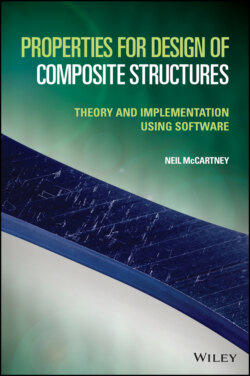Читать книгу Properties for Design of Composite Structures - Neil McCartney - Страница 53
3.4.2 Application of Maxwell’s Methodology
ОглавлениеTo apply Maxwell’s methodology to a cluster of N particles embedded in an infinite matrix, the stress distribution in the matrix at large distances from the cluster is considered. The perturbing effect in the matrix at large distances from the cluster of particles is estimated by superimposing the perturbations caused by each particle, regarded as being isolated, and regarding all particles to be located at the origin. The properties of particles of type i will again be denoted by a superscript (i).
The stress distribution at very large distances from the cluster is then given by the following generalisation of relations (3.38)
(3.41)
where from (3.40), for i = 1, …, N,
(3.42)
For the isolated sphere of radius b having the effective properties of the particulate composite cluster as illustrated in Figure 3.1(b), it follows that the stress field in the matrix at large distances is described exactly by relations of the type (3.38) where the coefficient Dm is replaced by D¯m having the value determined by the relation
(3.43)
where μeff is the effective shear modulus of the isotropic particulate composite. It then follows from (3.38) and (3.40) that the exact matrix stress distribution, for a given value of μeff, is
(3.44)
As the stress distribution given by (3.41) must be identical at large distances from the cluster with that specified by (3.44) it follows, from a consideration of terms proportional to r−3, that
(3.45)
where use has been made of (3.1). On substituting (3.42) and (3.43) into (3.45), it can be shown using (3.1) that the following ‘mixtures’ result is obtained for the function 1/(μ+μm*)
(3.46)
On using (3.1), the effective shear modulus may be estimated using the following relation
(3.47)
It can be shown that the bounds for the effective shear modulus derived by Hashin and Shtrikman [6, Equations (3.44)–(3.50)] and the bounds derived by Walpole [7, Equation (26)] are identical and may be expressed in the following form that has the same structure as the result (3.46) derived using Maxwell’s methodology
(3.48)
(3.49)
The parameters kmin and μmin are the lowest values of the bulk and shear moduli of all phases in the composite, respectively, whereas kmax and μmax are the highest values. On writing
(3.50)
it follows that μmax*≥μmin* for all values of the bulk and shear moduli, indicating that the ‘max’ and ‘min’ subscripts are used in an appropriate sense. It should be noted that kmin and μmin may be associated with different phases, and similarly for kmax and μmax.
